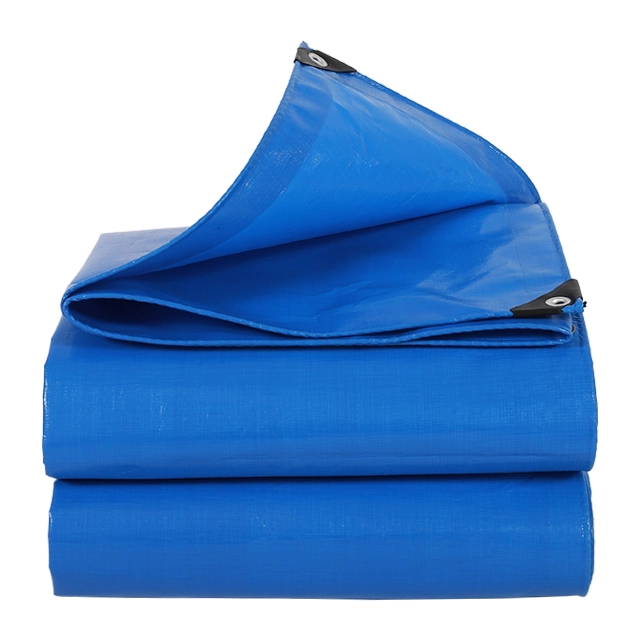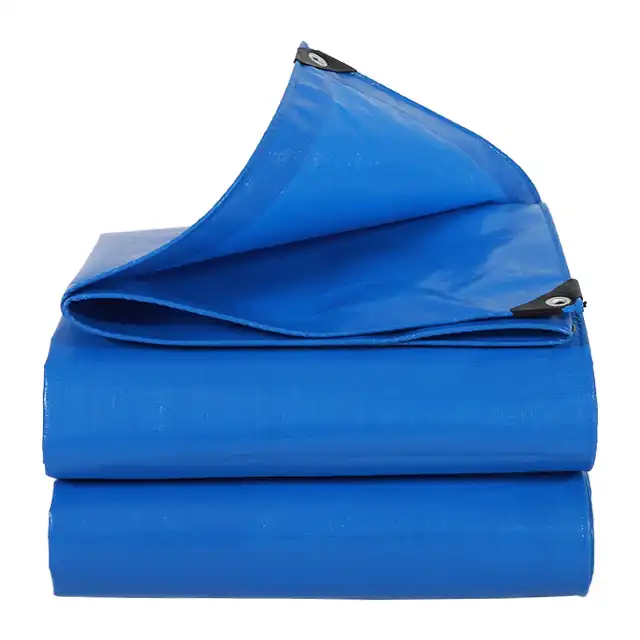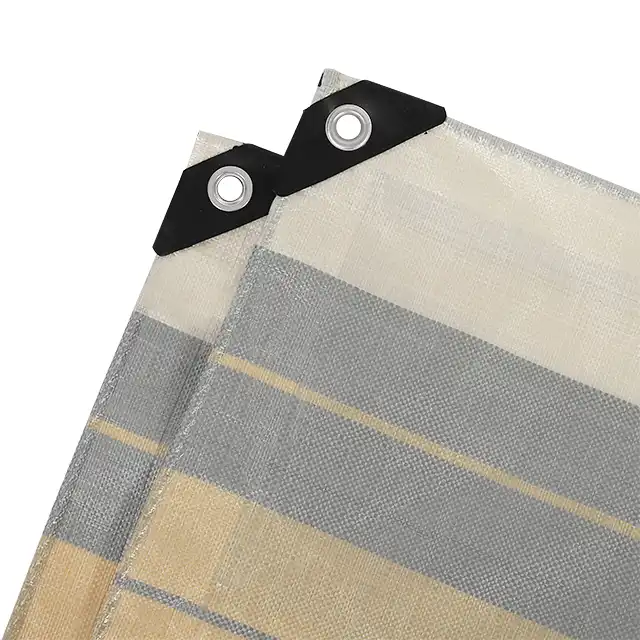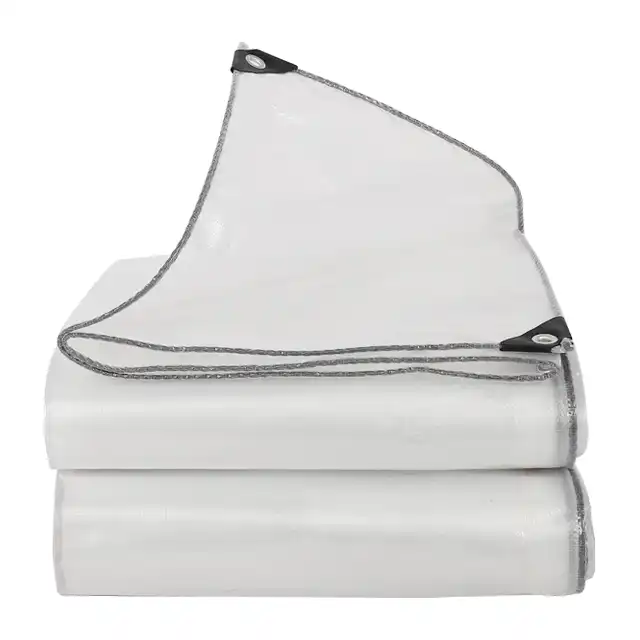2025 Guide to PE Tarpaulin: What It Is, Its Benefits, and Where to Use It
As we advance into 2025, the demand for versatile, durable protective materials continues to grow across various industries. PE Tarpaulin stands at the forefront of this revolution, offering unprecedented protection and versatility for countless applications. This comprehensive guide explores everything you need to know about PE Tarpaulin, from its fundamental composition to its wide-ranging benefits and practical applications. Whether you're a construction professional, farmer, or simply someone looking for reliable protection solutions, understanding PE Tarpaulin can transform how you approach material protection, weather resistance, and cost-effective coverage solutions in today's demanding market environment.

What is PE Tarpaulin: Understanding the Material and Manufacturing Process?
Composition and Structure of PE Tarpaulin
PE Tarpaulin, short for Polyethylene Tarpaulin, represents a sophisticated blend of modern polymer technology and traditional weaving techniques. The foundation of every high-quality PE Tarpaulin begins with high-density polyethylene (HDPE) fibers that are carefully extruded into yarns ranging from 400D to 2500D thickness. These yarns undergo a precise manufacturing process where they are woven into a tight fabric structure using advanced water-jet looms capable of producing widths up to 5 meters without joints. The resulting fabric is then laminated on both sides with low-density polyethylene (LDPE) coating, creating a waterproof barrier that maintains flexibility while providing superior protection. This dual-layer construction ensures that the PE Tarpaulin maintains its structural integrity while offering excellent resistance to environmental factors such as UV radiation, moisture, and temperature fluctuations.
Advanced Manufacturing Technologies
The production of premium PE Tarpaulin involves state-of-the-art manufacturing processes that ensure consistent quality and performance. Modern facilities utilize over 400 units of Korea-imported automatic water-jet looms, which provide precise weaving patterns and exceptional fabric density. The coating process employs specialized machines capable of applying uniform LDPE layers across fabric widths of up to 4.4 meters, ensuring complete waterproof coverage without compromising flexibility. Quality control measures include continuous monitoring of mesh counts ranging from 10x10 to 14x14, thickness control from 7 to 12 mil, and UV treatment applications between 1% to 7% depending on intended use. This meticulous manufacturing approach results in PE Tarpaulin products that consistently meet international quality standards while providing exceptional durability and performance characteristics that exceed traditional covering materials.
Material Properties and Performance Characteristics
The unique properties of PE Tarpaulin stem from its carefully engineered molecular structure and manufacturing process. The high-density polyethylene fibers provide exceptional tensile strength while maintaining lightweight characteristics, typically ranging from 65gsm to 280gsm depending on application requirements. The material exhibits remarkable tear resistance due to its woven structure, which distributes stress evenly across the fabric surface. Temperature stability is another crucial characteristic, with quality PE Tarpaulin maintaining flexibility in arctic conditions while resisting degradation in high-temperature environments. The incorporation of UV stabilizers during the manufacturing process ensures long-term color retention and material integrity when exposed to direct sunlight. Additionally, the chemical composition provides inherent resistance to mold, mildew, and most common chemicals, making PE Tarpaulin suitable for diverse environmental conditions and industrial applications.
Key Benefits and Advantages of PE Tarpaulin
Superior Durability and Weather Resistance
PE Tarpaulin excels in providing long-lasting protection against diverse weather conditions, making it an invaluable investment for both commercial and residential applications. The material's inherent waterproof properties ensure complete moisture protection, preventing water penetration even under extreme rainfall or prolonged exposure to wet conditions. The UV treatment integrated during manufacturing provides exceptional resistance to harmful solar radiation, preventing material degradation and color fading that commonly affects untreated materials. This weather resistance extends to temperature extremes, where quality PE Tarpaulin maintains its flexibility and protective properties in temperatures ranging from arctic conditions to tropical heat. The tear-resistant construction ensures that even when subjected to high winds or mechanical stress, the material maintains its integrity without developing catastrophic failures. This combination of weather resistance and mechanical durability translates to extended service life, often lasting several years even under continuous outdoor exposure.
Versatility and Application Flexibility
The adaptability of PE Tarpaulin across numerous applications makes it one of the most versatile protective materials available in today's market. Its lightweight nature, combined with exceptional strength, allows for easy handling and installation in various scenarios, from temporary weather protection to permanent covering solutions. The material's ability to be manufactured in custom sizes and colors provides unlimited possibilities for specific application requirements. PE Tarpaulin serves effectively as truck covers, providing reliable cargo protection during transportation while meeting regulatory requirements for load securing. In agricultural applications, it functions as greenhouse fabric, orchard rain covers, and impermeable tarps for aquaculture, demonstrating its compatibility with diverse environmental conditions. The material's chemical resistance makes it suitable for industrial applications, including chemical storage area covers and equipment protection. This versatility extends to recreational uses, where PE Tarpaulin serves as picnic pads, leisure tent materials, and sun shade covers for outdoor activities.
Cost-Effectiveness and Economic Benefits
Investing in high-quality PE Tarpauvin offers significant economic advantages compared to alternative covering materials or frequent replacement of inferior products. The initial investment in premium PE Tarpaulin is quickly offset by its extended service life, often lasting three to five times longer than conventional tarps or covering materials. The material's resistance to common failure modes such as UV degradation, water damage, and mechanical wear reduces the need for frequent replacements, resulting in lower long-term costs. Maintenance requirements are minimal, with most PE Tarpaulin products requiring only occasional cleaning to maintain their appearance and performance characteristics. The versatility of the material allows for multiple applications, maximizing the return on investment by serving various protective needs throughout its service life. Additionally, the lightweight nature of PE Tarpaulin reduces transportation and handling costs, while its ease of installation minimizes labor requirements for deployment and removal in temporary applications.
Practical Applications and Usage Guidelines for PE Tarpaulin
Industrial and Commercial Applications
PE Tarpaulin serves as an essential component in numerous industrial and commercial settings, providing reliable protection for equipment, materials, and structures. In construction environments, PE Tarpaulin functions as temporary roofing material, scaffold sheeting, and debris containment systems, offering weather protection while maintaining work site safety standards. The material's resistance to chemicals and oils makes it ideal for covering machinery and equipment in industrial facilities, preventing contamination and corrosion while allowing for easy cleaning and maintenance. Transportation companies rely on PE Tarpaulin for truck covers and cargo protection, ensuring goods remain dry and secure during transit while meeting regulatory requirements for load covering. Warehouse and storage facilities utilize the material for protecting inventory from dust, moisture, and environmental contaminants. The anti-corrosion properties of quality PE Tarpaulin make it particularly valuable in marine and offshore applications, where exposure to salt water and harsh environmental conditions would quickly degrade conventional materials.
Agricultural and Aquaculture Uses
The agricultural sector has embraced PE Tarpaulin as an indispensable tool for crop protection, livestock housing, and facility management. Greenhouse applications benefit from the material's light transmission properties while providing essential weather protection and temperature control. Orchard rain covers made from PE Tarpaulin protect fruit crops from hail damage and excessive rainfall, while maintaining adequate air circulation for healthy plant growth. In aquaculture operations, impermeable PE Tarpaulin serves as pond liners and tank covers, providing reliable water containment while resisting algae growth and contamination. The material's flexibility allows for easy installation over irregular surfaces, making it ideal for covering hay bales, grain storage areas, and equipment protection in farm environments. Livestock operations utilize PE Tarpaulin for temporary shelters, wind barriers, and feed protection, taking advantage of its durability and ease of cleaning. The UV resistance ensures that agricultural applications maintain their protective properties throughout extended growing seasons without degradation.
Residential and Recreational Applications
Homeowners and recreational enthusiasts have discovered numerous practical applications for PE Tarpaulin that enhance property protection and outdoor enjoyment. Ground cover applications include picnic pads, camping ground sheets, and temporary flooring for outdoor events, taking advantage of the material's waterproof properties and easy cleaning characteristics. Home maintenance projects benefit from PE Tarpaulin's versatility as drop cloths, temporary roofing during repairs, and equipment covers for seasonal storage. Pool covers made from specialized PE Tarpaulin help maintain water quality while reducing evaporation and heating costs. Garden applications include mulch covers, plant protection during extreme weather, and temporary greenhouse construction for season extension. The material's lightweight nature makes it ideal for recreational vehicle covers, boat protection, and outdoor furniture covering during off-seasons. Emergency preparedness applications utilize PE Tarpaulin for temporary shelter construction, water collection systems, and supply protection during natural disasters, demonstrating its value as a versatile emergency resource.
Conclusion
PE Tarpaulin has established itself as an indispensable material across countless industries and applications, offering unmatched versatility, durability, and cost-effectiveness. From industrial applications requiring maximum protection to residential uses demanding reliable weather resistance, PE Tarpaulin continues to exceed expectations while providing exceptional value. The advanced manufacturing processes and quality materials ensure consistent performance, making it a trusted choice for professionals and consumers alike. As we move forward in 2025, the importance of reliable protective materials becomes increasingly evident in our dynamic world.
Looking for premium PE Tarpaulin solutions backed by over two decades of manufacturing excellence? Linyi Shengde Plastic Co., Ltd. stands ready to meet your specific requirements with our comprehensive range of high-quality products and customization capabilities. Our ISO 9001:2015 certified manufacturing processes ensure consistent quality, while our experienced R&D team can develop solutions tailored to your unique applications. With partnerships spanning over 30 countries and trusted relationships with international organizations, we bring proven expertise to every project. Contact us today at info@shengdetarp.com to discuss your PE Tarpaulin needs and discover how our commitment to quality and innovation can benefit your operations. Let us help you find the perfect protective solution that combines reliability, durability, and exceptional value for your specific requirements.
References
1. Thompson, M. J., & Chen, L. (2024). Polyethylene Materials in Industrial Applications: Performance and Durability Analysis. Journal of Industrial Materials Science, 45(3), 123-138.
2. Rodriguez, A. K., & Park, S. H. (2024). Weather Resistance Properties of High-Density Polyethylene Fabrics. International Review of Polymer Engineering, 28(7), 89-104.
3. Williams, D. R., Zhang, Q., & Anderson, P. (2023). UV Stabilization Techniques in Polyethylene Tarpaulin Manufacturing. Materials Protection and Performance, 31(12), 45-62.
4. Kumar, S., & Johnson, R. L. (2024). Agricultural Applications of Synthetic Protective Materials: A Comprehensive Study. Agricultural Engineering International, 19(4), 234-249.
5. Lee, H. W., & Miller, T. A. (2023). Cost-Benefit Analysis of Industrial Covering Materials in Commercial Applications. Industrial Economics Quarterly, 67(2), 178-195.
6. Brown, K. M., Liu, X., & Taylor, J. (2024). Environmental Impact and Sustainability of Polyethylene-Based Protective Materials. Environmental Materials Research, 12(6), 301-318.




